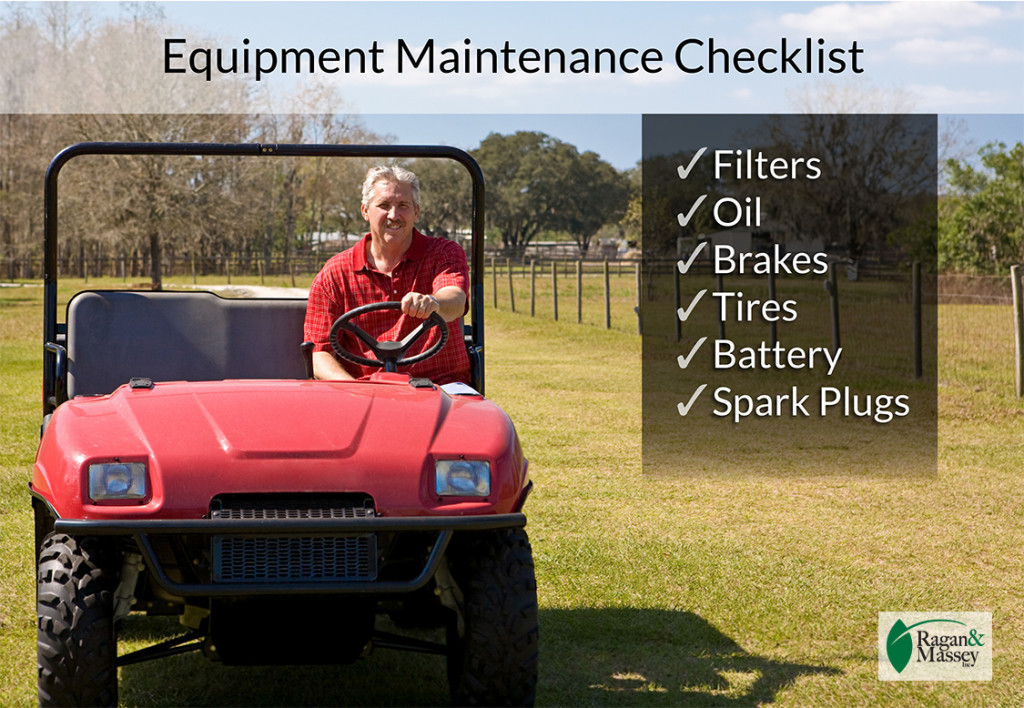Spring Equipment Maintenance
Whether the farm’s equipment and vehicles have been in storage waiting out the off-season or are just in need of a checkup, there are plenty of tasks that can be done now to make sure there are no hiccups when springtime is in full bloom. Here are a few typical equipment maintenance tasks to make sure the busy spring season goes off without a hitch.
Most of these tasks are applicable to all low-horsepower equipment, such as the farm UTV or ATV, small implements and small tractors that are commonly used on working properties of any size or focus.
Check or replace the filters
To avoid issues with an engine, it’s important to change filters as needed. Air and oil filters can typically be changed at the same time as the oil in your equipment. It is worth noting that an air filter may need to be changed more often depending on how dusty the work environment is.
Examine an air or oil filter to determine if it needs to be replaced. Dirty filters that should be replaced will be clogged, covered in oil and show signs of wear.
Change the oil
To ensure equipment stays in tip-top condition, regularly check and change the oil. If oil is not changed or checked, it could do some serious damage to the engine. For quality control, it’s recommended that oil be checked with every use. Refer to the equipment’s owner’s manual for more details.
Oil maintenance goes beyond changing the oil; it’s equally important to know what type of oil is best for equipment. While conventional oil is cheaper, synthetic oil works well in extreme temperatures and contains fewer contaminants than conventional oil.
Check the brakes
An accurate brake check should include an evaluation of the brake fluid and, if available, the brake pad wear indicator. If brake pads need to be replaced, it’s recommended to replace them in pairs (front pair, back pair). Take note if the brakes begin to chatter or grab, as that typically means there is an issue with the brake pads.
Inspect the tires
Depending on how often a machine is used, tires can take quite a beating. Ensuring that tires are fit to use will take more than a quick once-over. To avoid using over- or under-inflated tires, check the tire pressure with a tire gauge. Refer to the owner’s manual to determine what the recommended tire pressure is for the front and back tires. Going over or under that recommendation could result in machine damage and a ruptured tire.
Check the battery
The last thing anyone wants to deal with is a dead battery. If equipment has been in storage for months on end, chances are that the battery will need to be replaced. To avoid these issues, invest in a battery maintainer to keep your machine ready to roll after a long hibernation.
Check the spark plugs
Spark plugs will naturally wear out over time. Replacing old spark plugs can make a world of difference, adding new life to an old engine. To know when a spark plug is ready to be replaced, remove the spark plug and examine it for signs of wear. Be sure to clean the area around the spark plug before removing it to ensure that dust or dirt does not make its way into the engine.
When examining the spark plug, look for carbon buildup around the firing end and measure the gap between the center and the ground electrodes with a feeler gauge. Refer to the owner’s manual to determine what the distance should be. NGK offers an in-depth look at spark plug analysis here.
Flush the sprayer tank
If using a sprayer of any size, we recommend flushing the tank with a reliable product after any period of non-use and on a monthly schedule during the active season. Iowa State University offers in-depth guidelines for flushing a tank.
CAUTION: It is vital to read the cleaning instructions on every herbicide or pesticide used in your sprayer! Simply rinsing with water very rarely works, so be sure to know how to handle any substance that goes into your tank.
Flushing the tank after the off-season is a good opportunity to check all of your nozzles, hoses and screen. Look for corrosion or clogs on all spray nozzles and replace as needed. Check hoses for signs of wear or cracks. Inspect tanks screens for clogs or holes.
Stay tuned to this blog for an in-depth look at sprayer maintenance.
RELATED: Spray Tank Flush
